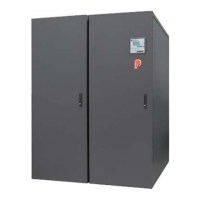Manual code 75803707A.0708
Page 47 of 64
10 LOCAL NETWORK
10.1 MASTER - SLAVE LOCAL NETWORK
Provides increased operating security in rooms where this is necessary through the Master - Slave
configuration. In this type of local network the units are all activated with the exception of one designated slave unit,
which remains on standby. The cooling capacity is thus divided between the active units until a critical situation or an
increase in demand causes the slave unit to be activated to meet the additional cooling requirement. During normal
operation, the units operate in rotation to ensure that the total operating hours are distributed evenly amongst all the
units.
The µAC microprocessor can control a maximum of 6 units, while the pCO microprocessor can control up to
8 units.
10.2 CASCADE LOCAL NETWORK(pCO)
Unlike the master - slaveversion, in rooms where the thermal load is not constant, it is possible to apply a
cascade type local network to increase energy savings. Normally only one unit is in operation and the other slave units
only start operating in the event of a critical situation to meet the increased thermal demand from the room in question.
During normal operation, the units operate in rotation to ensure that the total operating hours are distributed evenly
amongst all the units.
This function is only possible with the pCO microprocessor, which can control a maximum of 8 units.
10.3 CRITICAL SITUATIONS
The units in the local network are activated in the following critical situations:
• One of the circuit boards is without power (black-out);
• A major alarm is generated in one of the circuit boards;
• One of the circuit boards is disconnected from the network (line disconnected);
If a critical situation arises on one of the standby units, no action is taken by the network other than to signal the
alarm on the unit in question.
10.4 EMERGENCY OPERATION
• MASTER - SLAVE UNITS UNITS
• UNITS IN CASCADE NETWORK (pCO)

